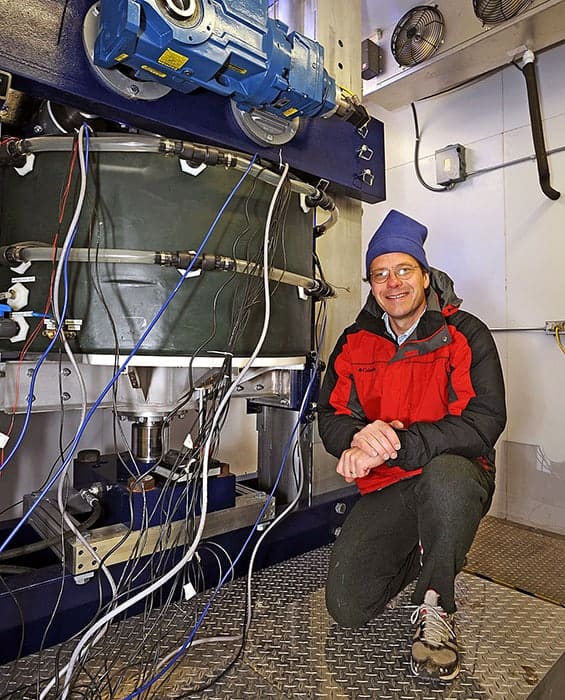
An equation that describes motion of glaciers over soft, deformable ground has been developed by Neal Iverson of the Iowa State University and Lucas Zoet of the University of Wisconsin-Madison in the US. Their new “slip law” was derived from lab experiments and could help remove uncertainties from existing glacial flow models. Indeed, models that include the slip law predict more rapid ice sheet discharges into the oceans in the future – leading to additional sea level rise.
Understanding how glaciers move over different types of terrain is vital to predicting how much glacial melt will contribute to changes in sea level. However, there are currently large gaps in our knowledge – particularly for fast-flowing, ocean-reaching glaciers. These can be found in Antarctica and Greenland, where they lie on soft, glacially-deposited sediment called till.
“Glacier ice is a highly viscous fluid that slips over a substrate – in this case a deformable till bed – and friction at the bed provides the drag that holds the ice back,” Iverson explains. “In the absence of friction, the weight of the ice would cause it to accelerate catastrophically like some landslides,” he adds.
Data are difficult to obtain
Obtaining data on glacial drag in the field, however, is extremely difficult. Drilling to the bottom of the ice to make measurements, for example, would inherently change the nature of the interface between the glacier and the bed.
Taking a different approach, Iverson and Zoet have been simulating their very own glaciers in the lab. In 2009, Iverson built a ring-shear device that features a ring of ice 20 cm thick and 0.9 m in diameter that can be rotated at speeds of between 0.3–3048 metres per year over a chosen substrate. This occurs within a hydraulic press that can squeeze the ice to simulate the weight of an overlying glacier that is 244 m thick.
The device is stored in a walk-in freezer, with the ring surrounded by a circulating fluid that keeps the ice just at its melting point, so it slides along a thin film of water – like all fast-flowing glaciers do. For the simulated base under the ice, the researchers used real glacial till with the correct mix of mud, sand and larger rock particles.
“We were after the mathematical relationship between the drag holding the ice back at the bottom of the glacier and how fast the glacier would slide,” Iverson says. “That included studying the effect of the difference between ice pressure on the bed and water pressure in the pores of the till – a variable called the ‘effective pressure’ that controls friction.”
Dominant slip mechanism
From their experiments, the duo found that glaciers slide atop soft sediments at slower speeds, but once they reach a certain threshold speed, they begin to deform the underlying sediment – a process which then becomes the dominant slip mechanism.
“We are able to provide a mechanical reason for when this transition would happen and also provide a more generalized equation that could be used in ice-sheet models to simulate this process,” Zoet tells Physics World, explaining that the effective pressure is what controls the strength of the sediment bed and the resulting transition to bed deformation that changes the glacier’s drag.
When combined with the equivalent equation for glacier movement over hard beds, the researchers’ findings have the potential to be used to create a general slip law that could be applied to all glacier flow models, removing previous uncertainties.
“Higher rates of sea-level rise”
“Ice sheet models using our new slip relationship would tend to predict higher ice discharges to the ocean – and higher rates of sea-level rise – than slip laws currently being used in most ice sheet models, Iverson added.
Martin Truffer, a geophysicist from the University of Alaska commended the work, noting that others models “have a notoriously difficult time with […] boundary processes and a vast majority still use rules for basal motion that are not supported by observations.”
“One of the hardest problems in glaciology is how to parametrize basal motion of large ice sheets,” says Hilmar Gudmundsson, a glaciologist from Northumbria University. “In the past a lot of arguments have focused on if basal sliding is a viscous or a plastic process. This new work suggests that both of the processes are possible: at low sliding velocities we have the viscous limit, at high velocities we reach the plastic limit.”
Gaining further insights
With their initial study complete, the researchers are now looking to gain more insight into how the rates of sediment deformation change when variables such as ice velocity and effective pressure change.

Fast-moving glaciers slide more easily
“Developing a relationship that allows us to estimate the sediment deformation rate at the glacier’s base will give us a missing piece of information in estimating how long it takes glaciers to build and destroy landforms,” such as those found over much of Europe, North America and the base of Antarctica, Zoet says. “Using the new ring shear apparatus with a transparent sample chamber we can observe this directly.”
The research is described in Science.



